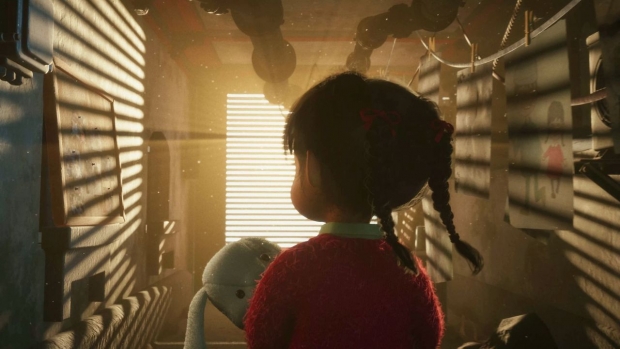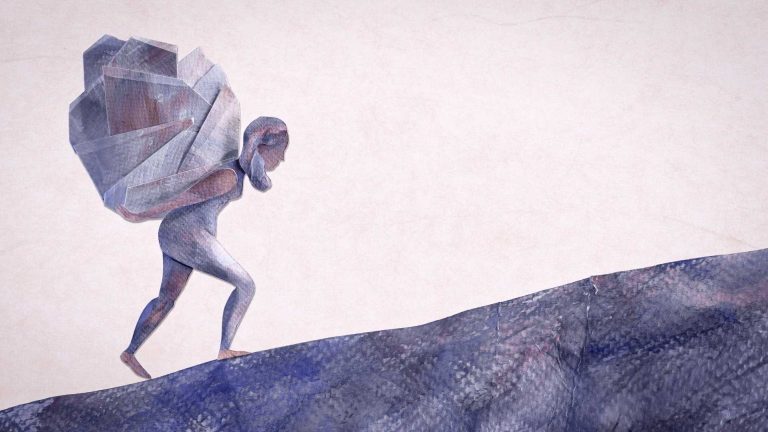Take a few minutes to enjoy the film:
“Windup is inspired by my own personal experiences,” the director shares. “I was often sick when I was a kid, though my memory of those days is kind of foggy. From my parents’ perspective, those events were way more serious. They told me they’d spend countless nights taking care of me and fighting with their own emotions. I didn’t understand why my parents were so worried when I was a kid, but as I got older, I started to empathize with them. By then, I’d moved to the U.S., far from home, which is Wuhan, China. Now, I’m the one who always worries about them, especially after the news of the whole city shutting down [because of the pandemic]. I got word that my uncle had to stop his cancer treatment because of the overwhelming number of COVID patients. Also, both my cousins were still working at the hospital where many of their co-workers were already infected. It was worrisome.”
[embedded content]
Reflecting on what his uncle Glen notes about animating a character, Keane says, “We’re able to produce animation faster than I’ve ever done anywhere else. And to be honest, some of that faster animation came out a little bit better. It’s like my uncle talking about how he loves his rough drawings. He strongly believes to that the faster we can get what’s in our hearts and minds onto paper or the screen, the more it shines. It showcases the performance of the actor, which is the animator. I felt like that rang true animating with the real-time engine here.”
The challenge of using the new real-time gaming technology was made even more difficult by the configuration of the team; Jiang had to setup and manage artists spread around the world. “Our team of artists was from 10 different countries,” she reveals. “It was hard at first to imagine just how that would work. Half the team was from AAA games, so they knew how to use the game engine quite well. The other half was from feature films, and they knew how to achieve feature film quality. But for most of us, it was the first time collaborating on a project trying to get feature film quality using real-time tools. Making it even harder was that most of us worked at home on our personal computers. Production had to run smoothly on regular desktops because if they crashed for one person, nobody could work. But we did it.”

“But with real-time, you benefit from seeing the lighting and how the hair moves, or the clothing, the glint in the eye, the tear on a father’s cheek, that also tell a lot of the story too,” he adds. “As an animator, being able to see things more connected with the character, quickly, from our mind and hearts right to the screen in a final image… the more we believe it, the more authentic the performance is.”
For Chinese filmmaker Yibing Jiang and game engine technology company Unity, the project began, simply enough, as a technical “proof of concept” for producing film-quality animation using real-time gaming tools. But soon, increasingly positive responses to Jiang’s initial tests, shown at GDC and within the company, soon led to a modest budget and even more modest timeframe for her to push ahead and produce an animated short film. Armed with a personal story she’d been thinking about for years and a small, international team of artists working remotely and mostly part-time, Jiang wrote and directed Windup, a touching and graceful animated short about the bond between a loving father and his ailing daughter, created using real-time tools previously used for primarily for video games, that powerfully showcases how such technology is fundamentally changing the way compelling, high-quality animation is being produced.
Though Jiang had kicked around the story idea for quite some time, she began the project as a technology test rather than a short film production. “We made the test scene back in 2017,” she says, “with just me and a lighting artist in Paris, collaborating to make something beautiful.” After showing the test around at GDC, Unity insiders were impressed enough to approve the short film’s production, which took nine months, completing in February 2020; Keene joined as animation director in month three, having never animated using real-time rendering technology. He was enamored from the beginning.
“The idea behind real-time rendering is what you see is what you get,” Jiang explains. “Traditionally, artists have to imagine what the final film will look like because with each step, what they’re seeing is quite different from the final film. It’s quite common that on an animation production, there’s a lot of polishing work that drags on all the way to the very end, which is when nobody sleeps. By that time, you can actually get some pictures closely resembling the final image. But real-time rendering changes that. Each department can work and collaborate at the same time. It’s not like stepping through the sequence of who can now work on an environment or character. Everyone can work together and polish the materials in parallel.”
“Though I video chat with them, once the camera turns off, all these horrible thoughts just rush back in,” she continues. “I remember a time we were crunching on the film, animating the hospital sequence where the father feels hopeless as he sits down in defeat on the floor. I could totally sympathize with his pain. I guess this is a good example of how life imitates art, especially now, at a time when people around the world are isolated, craving for connection, preoccupied with the health and wellbeing of loved ones. The story of Windup is extremely relevant.”

In Windup, a father tries to connect with his unconscious daughter through a favorite childhood tune. To do this, he plays a windup music box over and again in the hope that she will hear it, while fighting with his own emotions to stay strong.
Keane was quite amazed the first time he used the technology. “The first scene I did, I remember, when I popped it into Unity, I was wowed. You saw the little particles in the light hitting the movement I was creating. It was like, ‘She’s alive!’ It inspired me. And with the lighters, they were all working simultaneously, and would see the animation happening as we created it. And that inspired them.”
“It’s my first time being a director, so I made a lot of mistakes,” she acknowledges. “I really tried to make sure the story was good before the production started, but we kept changing things to make sure we knew the theme, and each shot really made sense. Sometimes, seeing the real-time rendered environment of the next shot helped us make better changes to the story.”
Windup is produced by Aleksander Karshilkoff and Silvia Rasheva, with Jason Keane serving as animation director. Keane boasts some impressive family animation and artistic cred; his grandfather Bill Keane created the Family Circus comics, now produced by his uncle Jeff Kean, while his uncle Glen Keane is best known for his famed work at Disney on films like The Little Mermaid and Beauty and the Beast, as well as his Oscar-winning short, Dear Basketball and animated feature, Over the Moon, released last year on Netflix. No pressure there.


Noting how real-time rendering helped streamline the animation process, Keane says, “It’s great. The faster you can see your work, the more authentic your performances are. In feature films, we don’t see that final render. You can see your work on a screen maybe three months after you’re done animating, even though animation is the bulk of the film’s performance.”

Jiang laughs when sharing, “While Jason was animating, I kept changing the story,” describing how it was quite easy for the production to address new ideas and scenes as she made changes. “It was pretty easy in real-time production,” she says. “When the story changes, we can actually move a character and whole sets of animation into a completely different environment, which is totally unthinkable in the traditional pipeline.”
“To Yibing’s credit as a director, one of the great things she brought was letting everyone’s artistic capability shine within the team,” Keane chimes in. “Half the team was from film and half from games. This person’s in China, and this person’s in Sweden. She was able to get everyone working together beautifully and seamlessly and it all ran perfectly. It was awesome.”
Unity’s real-time tools allow rendered images and scenes to be reviewed instantly; departments can work simultaneously, rather than sequentially, collaborating and polishing animation in ways not previously possible. Characters can be animated in already lit scenes; animators can see final-quality shots in real-time, not months down the line. It completely changes the dynamic of how artists create, iterate, and refine their work.

Dan Sarto is Publisher and Editor-in-Chief of Animation World Network.







